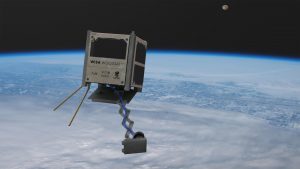
The proposed nanosatellite is based on the CubeSat standard, measuring roughly 10 x 10 x 10cm. It will be exposed to extreme space conditions – heat, cold, vacuum and radiation – for an extended period of time.
Dubbed “the first wooden satellite in the world”, the mission was initiated by Jari Makinen, a Finnish writer and broadcaster who has co-founded a company called Arctic Astronautics.
The plywood Wisa Woodsat satellite is due to be launched to space during the “fall of 2021” with a Rocket Lab Electron rocket from the Mahia Peninsula launch complex in New Zealand.
ESA
Materials experts at the European Space Agency are contributing a suite of experimental sensors to the mission as well as helping with pre-flight testing, the agency reports.
“It’s been a tight schedule but we welcomed the opportunity to contribute to Woodsat’s payload in return for helping assess its suitability for flight, said Riccardo Rampini, the head of ESA’s Materials’ Physics and Chemistry section. “The first item we’re embarking is a pressure sensor, which will allow us to identify the local pressure in onboard cavities in the hours and days after launch into orbit. This is an important factor for the turn-on of high power systems and radio-frequency antennas, because small amounts of molecules in the cavity can potentially cause them harm.
“This sensor is being built for us by Sens4 in Denmark, who have done a great job to strip down their standard design to fit limited onboard volume and power constraints.”
The world’s first wooden satellite is on the way, in the shape of #Finland’s @wisawoodsat. #ESATech materials experts at #ESTEC in #NL are contributing a suite of experimental sensors to the mission as well as helping with pre-flight testing https://t.co/mm4Ofq8cHw pic.twitter.com/VAEouuYerN
— ESA Technology (@ESA_Tech) June 10, 2021
You can read more about Wisa Woodsat on the WisaPlyWood website. A video of its test stratospheric flight, on 12 June from the Heureka Science Center in Finland, is below.
It is reported that the successful test – of the satellite’s camera and communication equipment – lasted for almost three hours and reached an altitude of 31.2 km.